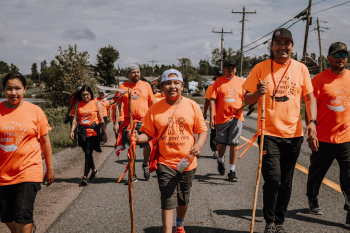Image Caption
Summary
Local Journalism Initiative Reporter
Windspeaker.com
When 10-year-old Nimkii Cameron first heard the news about the 215 children’s remains located in a mass, unmarked grave at the site of the former Kamloops Indian Residential School in British Columbia, he knew he had to do something to acknowledge it.
Inspired by his uncle Terry Bunting, who just completed a walk of about 160 kilometers from Grassy Narrows First Nation in Ontario to the McIntosh Indian Residential School, Nimkii and his seven-year-old sister Nahanii decided to walk from their home of Niisaachewan Anishinaabe Nation to the site of Cecilia Jeffrey Residential School located in northern Ontario.
The walk’s purpose was twofold: to raise awareness about the legacy of the residential school system in Canada, and to re-ignite a dialogue about the lack of Indigenous-focused programming in school curriculum. Nimkii was studying Egyptian history in school and did not understand why Indigenous history was not being taught in his class.
His father Reno recalled the first conversation that sparked the idea for the walk, noting the gaps in the typical Canadian student’s knowledge about residential schools. It had been a topic Reno had discussed in his own youth.
“Nimkii said to me, ‘This is not our way. This is not our history, Dad. This has to be changed.’ We brought these conversations up when I was young, and it’s still the same,” Reno said.
The walk to Cecilia Jeffrey Residential School was a little over 20 kilometres in total. It took place over a four-day span earlier this month.
Each day, Reno, his partner Shalon, Nimkii, and Nahanii would get up at the crack of dawn, often around 4:30 a.m., in order to begin the walk for the day.
After eating breakfast and getting their supplies set for the day, early mornings were the norm until the walk was completed.
“It was all on Nimkii’s direction,” Reno said. They’d go in about five kilometre intervals each day, and then return home before restarting the next morning. Reno and Shalon would still have a full day’s work ahead of them after finishing off the walk.
“We were very tired,” Reno said. “But I believe any other parents would do the same to show the love and support of their kids’ dreams.”
Often travelling on uneven surfaces like gravel, the walk took a physical toll on their bodies. Nimkii and Nahanii carried a staff decorated with an eagle feather and an orange flag that would signify the front of the group.
“That staff can’t stop. It has to keep going,” Reno relayed Nimkii’s words.
“It took us about a week-and-a-half to get fully recovered from the walk,” Reno said. The Cameron family walked alongside whoever was willing, Nimkii and Nahanii’s grandparents on both sides, community Elders, and other local children that were supportive of the walk.
When they got into the city of Kenora nearing the end of the walk, Reno thought that the construction work in town might cause the walk to be delayed or otherwise obstructed. He was pleasantly surprised to see the local workers supporting his children’s cause.
“They stopped their work,” Reno said. “They told us to keep walking and that they were proud for what the kids were raising awareness about.”
Though this year’s version of the walk is over, Nimkii and Nahanii plan to undertake similar walks in the area on an annual basis moving forward.
The Cameron family also plans to visit Kamloops B.C. one day in order for Nimkii and Nahanii to pay respect to the 215 children.
Despite their ages, both of the children have big dreams for their own futures. Each wants to play professional hockey when they grow up. If that doesn’t work out, careers in the medical field or social work are what they’re looking to accomplish.
“They just want to help everybody. It’s amazing to us,” Reno said. “It’s how my partner and I were brought up, and they have the same goal, to help everyone and to treat everyone fairly.”
Local Journalism Initiative Reporters are supported by a financial contribution made by the Government of Canada.

